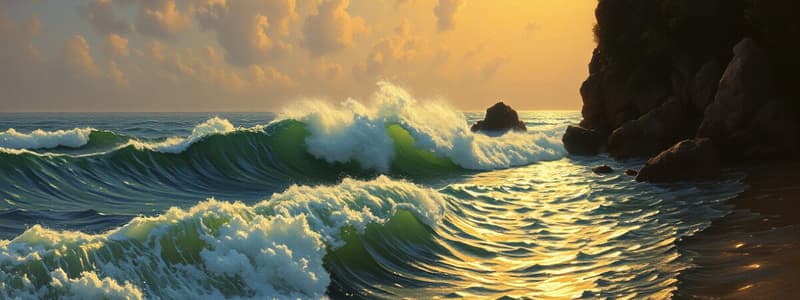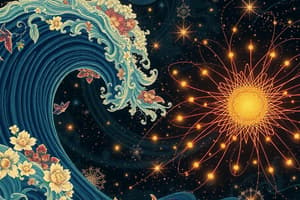Podcast
Questions and Answers
Who formulated the principle behind electromagnetic induction?
Who formulated the principle behind electromagnetic induction?
- Hertz
- Faraday (correct)
- Oersted
- Maxwell
Electromagnetic waves can only travel through a medium and not through vacuum.
Electromagnetic waves can only travel through a medium and not through vacuum.
False (B)
What is the speed of electromagnetic waves in a vacuum?
What is the speed of electromagnetic waves in a vacuum?
300,000,000 m/s
The transfer of energy in the form of EM wave is referred to as _____.
The transfer of energy in the form of EM wave is referred to as _____.
Match the scientist with their contribution to the field of electricity and magnetism:
Match the scientist with their contribution to the field of electricity and magnetism:
Which of the following is a characteristic of electromagnetic waves?
Which of the following is a characteristic of electromagnetic waves?
Electromagnetic waves can convert energy into different forms when interacting with matter.
Electromagnetic waves can convert energy into different forms when interacting with matter.
How long does it take for the rays of the sun to reach Earth?
How long does it take for the rays of the sun to reach Earth?
What is created when you move your hands up and down while holding one end of a rope?
What is created when you move your hands up and down while holding one end of a rope?
Moving your hands slowly while holding the rope creates waves that look the same as when moving them quickly.
Moving your hands slowly while holding the rope creates waves that look the same as when moving them quickly.
What relationship did Oersted's discovery establish?
What relationship did Oersted's discovery establish?
The phenomenon of accumulating electricity and magnetism is known as __________.
The phenomenon of accumulating electricity and magnetism is known as __________.
Match the following physicists with their contributions to electromagnetic theory:
Match the following physicists with their contributions to electromagnetic theory:
What type of waves are created when an electrically charged object moves back and forth in space?
What type of waves are created when an electrically charged object moves back and forth in space?
Ampere's Law describes the electric force between two electrical currents.
Ampere's Law describes the electric force between two electrical currents.
Name one of the physicists who contributed to the understanding of electromagnetic theory.
Name one of the physicists who contributed to the understanding of electromagnetic theory.
What phenomenon did Michael Faraday discover in 1831?
What phenomenon did Michael Faraday discover in 1831?
Joseph Henry was the first to discover electromagnetic induction.
Joseph Henry was the first to discover electromagnetic induction.
What was the world record that Joseph Henry's electromagnet could support?
What was the world record that Joseph Henry's electromagnet could support?
The speed of electromagnetic waves, as concluded by Maxwell, is _____ m/s.
The speed of electromagnetic waves, as concluded by Maxwell, is _____ m/s.
Match the following scientists with their contributions:
Match the following scientists with their contributions:
Which of the following describes one of Maxwell's principles of electromagnetism?
Which of the following describes one of Maxwell's principles of electromagnetism?
Hertz was able to generate electromagnetic waves before Maxwell proposed their existence.
Hertz was able to generate electromagnetic waves before Maxwell proposed their existence.
Which scientist improved the design of electromagnets by insulating the wire?
Which scientist improved the design of electromagnets by insulating the wire?
What happens to the wavelength when the frequency of an electromagnetic wave increases?
What happens to the wavelength when the frequency of an electromagnetic wave increases?
The amplitude of a wave indicates the frequency of an electromagnetic wave.
The amplitude of a wave indicates the frequency of an electromagnetic wave.
What is expressed in Hertz (Hz)?
What is expressed in Hertz (Hz)?
The highest point of an electromagnetic wave is called a ______.
The highest point of an electromagnetic wave is called a ______.
Match the following terms with their definitions:
Match the following terms with their definitions:
Which statement best describes the relationship between energy and frequency of electromagnetic waves?
Which statement best describes the relationship between energy and frequency of electromagnetic waves?
The trough of a wave represents the point of maximum field strength.
The trough of a wave represents the point of maximum field strength.
One hertz equals one ______ per second.
One hertz equals one ______ per second.
Which statement is true regarding the frequency of electromagnetic waves?
Which statement is true regarding the frequency of electromagnetic waves?
The electric field and magnetic field in electromagnetic waves oscillate in the same direction.
The electric field and magnetic field in electromagnetic waves oscillate in the same direction.
What happens to the frequency of electromagnetic waves as the temperature of an emitting object increases?
What happens to the frequency of electromagnetic waves as the temperature of an emitting object increases?
The combination of oscillating electric and magnetic fields forms an __________ wave.
The combination of oscillating electric and magnetic fields forms an __________ wave.
Match the following properties of electromagnetic waves with their descriptions:
Match the following properties of electromagnetic waves with their descriptions:
How does the wavelength of electromagnetic waves relate to their frequency?
How does the wavelength of electromagnetic waves relate to their frequency?
All electromagnetic waves require a medium to propagate.
All electromagnetic waves require a medium to propagate.
What induces the electric field in an electromagnetic wave?
What induces the electric field in an electromagnetic wave?
Flashcards are hidden until you start studying
Study Notes
Wave Creation Experiment
- Tying one end of a rope to a sturdy object allows for wave generation by moving the other end up and down.
- Observing wave patterns varies by hand movement speed: fast hand movements create sharper waves, while slower movements yield gentler waves.
Electromagnetic Waves
- Electromagnetic waves (EM waves) are created by moving electrically charged objects in space, similar to waves on a rope.
- These waves transfer energy and can move through a vacuum as well as through various media.
History of Electromagnetic Theory
- Hans Christian Oersted (1820): Discovered the link between electricity and magnetism by observing magnetic needle deflection near a current-carrying wire.
- Andre-Marie Ampere: Formulated Ampere's Law, detailing the magnetic force between electric currents.
- Michael Faraday: Established electromagnetic induction, demonstrating that an electrical current could be generated from a changing magnetic field.
- Joseph Henry: Innovated electromagnets with insulated wire, achieving significant power increases and first noted self-induction principles.
- James Clerk Maxwell: Unified electricity and magnetism, proposing that changing electric and magnetic fields can propagate as waves in space, concluding that EM waves travel at 3 x 10^8 m/s.
- Heinrich Hertz: Confirmed the existence of electromagnetic waves through experimental setups after Maxwell's death.
Properties of Electromagnetic Waves
- EM waves are disturbances that carry energy, capable of traveling through vacuums and mediums without losing energy.
- They travel at 300,000,000 meters per second, taking 8 minutes to reach Earth from the Sun.
- Interaction with matter can convert EM energy into different forms.
Characteristics and Terms
- Crest: Highest point of a wave, strongest field moment.
- Trough: Lowest point of a wave, weakest field moment.
- Wavelength: Distance between successive wave crests or troughs; shorter wavelength typically means higher energy.
- Frequency: Number of wavelengths passing a point in a given time, expressed in Hertz (Hz).
- Amplitude: Measures energy carried by a wave, defined by distance from midpoint to crest or trough.
Practical Applications
- EM waves have diverse applications due to their properties, such as in telecommunications and various energy transfer methods.
- Reflecting EM waves is demonstrated in activities involving remote controls and mirrors, highlighting practical experimentation of wave properties.
Studying That Suits You
Use AI to generate personalized quizzes and flashcards to suit your learning preferences.



